Maximum Minimalist—The Carl Andre Retrospective: Interview with Co-Curator Yasmil Raymond by David Ebony
David Ebony—
When I was in college in the mid-1970s, Carl Andre was god. For those of us striving to be serious artists, writers, and art historians, Andre was the paragon. His art was coolly intellectual, deceptively simple and austere, yet surprising and provocative. Minimalism was all the rage at the time, and compared with works by the movement’s other chief practitioners, Donald Judd, Dan Flavin, Robert Morris, Richard Serra, Eva Hesse, Robert Mangold, Sol LeWitt, among them, Andre’s art seemed to be the purest, the most conceptually rigorous, politically correct, and engaging.
He not only changed the notion of what a sculpture could be, but also radically altered the role of the artist and the terms of artistic practice. His work was not studio generated—all of his exhibitions were created on site. He used locally produced industrial materials like steel plates and wood beams to create simple arrangements of the nearly unaltered elements. Always controversial, his process sparked a tense discourse on labor and exchange value—the transformation of manufactured raw materials of intrinsic worth into artworks with culturally assigned aesthetic and market values.
Born Carl George Andre in Quincy, Mass., in 1935, he studied at the Phillips Academy in Andover, Mass. Inspired early on by the work of Constantin Brancusi, Andre produced totemic carved wood sculptures in the 1950s, before developing in the 1960s the spare sculptural vocabulary for which he is best known. He settled in New York City in the late 1950s, and began to show at Tibor de Nagy, and later caused a stir with a series of exhibitions at John Weber, Paula Cooper, Dwan Gallery in Los Angeles, and Konrad Fischer in Dusseldorf, among other venues. By the mid-1970s his career and reputation were firmly established.

Installation view, Carl Andre: Sculpture as Place, 1958–2010, Dia:Beacon, Riggio Galleries, Beacon, New York. May 5, 2014–March 2, 2015. Art © Carl Andre/Licensed by VAGA, New York, NY. Photo: Bill Jacobson Studio, New York. Courtesy Dia Art Foundation, New York.
A private tragedy struck in 1985, and made front-page news, when Andre’s wife, the Cuban-born artist Ana Mendieta, fell to her death from the window of the couple’s SoHo apartment. Andre was charged and brought to trial, but maintained his innocence and was eventually acquitted of any wrongdoing. Nevertheless, the case, which lasted three years, significantly damaged Andre’s public image. Subsequently, he became reclusive, although he continued to create works and exhibited regularly, especially in Europe.
Now nearly 80, in frail health and retired, Andre no longer produces art. He recently participated as a consultant, however, in a full-scale retrospective of his work at the Dia Art Foundation in Beacon, New York. On view through March 2, 2015, “Carl Andre: Sculpture as Place, 1958–2010,” is the artist’s first U.S. survey in many years. Co-organized by former Dia director Philippe Vergne (now director of L.A. MoCA) and Dia curator Yasmil Raymond, the exhibition makes its only U.S. appearance at Dia before an international tour, including stops in Madrid, Berlin, and Paris, through February 2017.
Accompanied by a scholarly catalogue, the show contains a broad selection of key sculptures spanning five decades, a number of vitrines filled with Andre’s writings, plus a display of archival material and a rarely exhibited series of small works known as “Dada Forgeries.” I recently met with Raymond at Dia’s New York City offices to discuss the exhibition and her personal views of Andre and his work.
David Ebony: In your essay for the show’s catalogue you start out by discussing archaic Greek kouros and kore statues. How and why did you decide on that approach?
Yasmil Raymond: I think it came from a desire to understand how the first artists emerged—how art emerges in civilization. I’m referring to a specific piece in the Met [Kouros (Youth), ca. 590–580 B.C.]. You get a clear sense of the artist, or, rather, the genius of the artist. It’s a work that is a “type” but there are differences in style and the rules of craftsmanship of the period. There’s a sense of autonomy—maybe that’s what I was after—the idea of an artist claiming her or his autonomy. There are only a few works we consider masterpieces, in which we grasp the feeling of rebellion and the artists asserting themselves.
Ebony: And you apply that idea to Carl Andre’s work.
Raymond: It’s more the attitude I was hoping to evoke, about leaving the conventions behind or stepping away from conventions. It’s a transitional piece. When you notice the position of the feet, you get a sense of movement. This is a figure that is stepping forward. There is a specific action that is happening in the sculpture. I feel that it’s a gesture that Carl Andre made when he first invited viewers to step onto one of his metal-plate floor sculptures. At that moment, the sculpture became about place and about choreography.
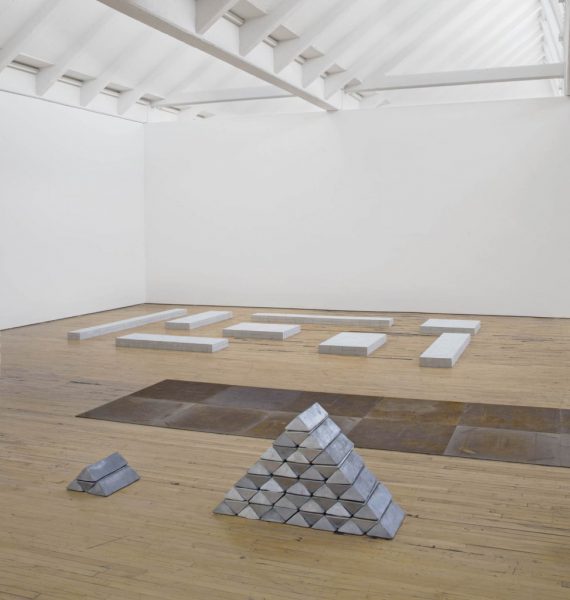
Installation view, Carl Andre: Sculpture as Place, 1958–2010, Dia:Beacon, Riggio Galleries, Beacon, New York. May 5, 2014–March 2, 2015. Art © Carl Andre/Licensed by VAGA, New York, NY. Photo: Bill Jacobson Studio, New York. Courtesy Dia Art Foundation, New York.
Ebony: Can you elaborate on the relationship between Andre’s work and choreography?
Raymond: The history of 1960s and ’70s art that has been told to me, and to almost everyone, is a story that excludes a lot of people, especially dancers, musicians, and other performers. I’ve always questioned the story and tried to imagine another way of looking at contemporary art. In this case, I knew that the choreographer Yvonne Rainer was important to Andre in this period. In my research, I found a letter from him to Rainer, handwritten with words wrapping around the edges of the paper. To read it requires a kind of choreographed movement of the hand. Carl sent it to her when she was ill and had just had a serious operation. But it’s no ordinary get-well card. I immediately understood that you have to love someone to write a letter like that.
I realized that there was something unfolding here. The letter prompted me to explore the impact of Rainer’s art and choreography on Andre’s work. In 1966, Andre gave Rainer a series of Styrofoam sculptures to use in one of her performances. Dance was important to him at this time. In another letter, Andre briefly mentions going with Hollis Frampton to see a Balanchine performance. For me, this is the exciting part of research. Art history is not all about the hard facts. It’s about associations, ways of thinking and attitudes toward ideas. I feel that reading Carl Andre’s work only through the lens of Donald Judd and Dan Flavin is incorrect. There’s so much more there—so much that has yet to be written.
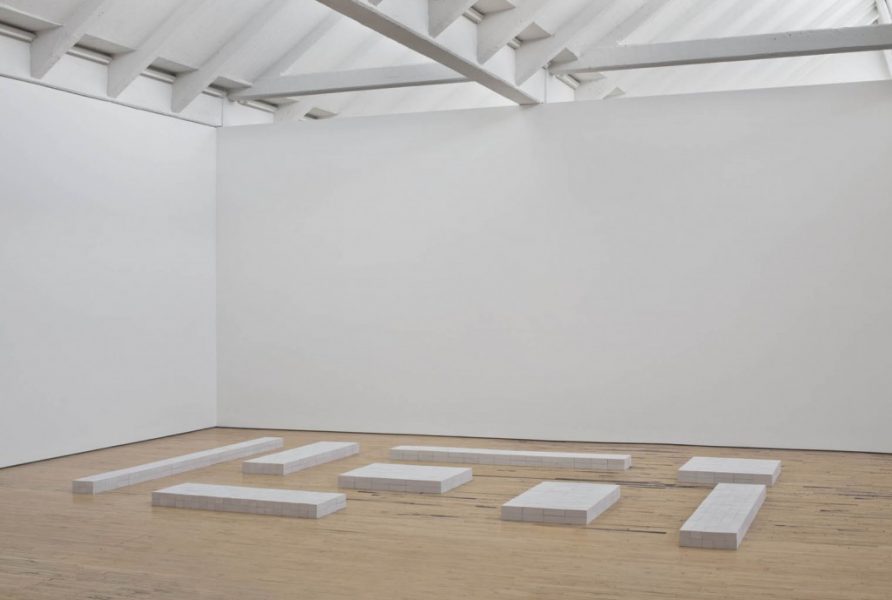
Installation view, Carl Andre: Sculpture as Place, 1958–2010, Dia:Beacon, Riggio Galleries, Beacon, New York. May 5, 2014–March 2, 2015. Art © Carl Andre/Licensed by VAGA, New York, NY. Photo: Bill Jacobson Studio, New York. Courtesy Dia Art Foundation, New York.
Ebony: What was it like to work with Andre on this show? I know it surprised a lot of people that he was directly involved with it.
Raymond: When Philippe Vergne first approached Carl about the exhibition, he said he was retired and did not want to be involved. But we didn’t want to make a show that he wouldn’t support or accept. We persisted and Carl changed his mind. He has never been interested in curatorial practice or exhibition making, but his entire career has been about responding to a specific site, so it was important that he become involved.
He visited Dia Beacon, and I began working on the show with him in 2010. He never disappointed me. I visited him monthly or every other month for about two years. He approved the floor plans—we had come up with hundreds of variations—and the checklist that would include Dada Forgeries and poetry as well as sculpture. He also made his archives available to us.
Ebony: What is his world-view like these days? His politics have always been interesting. Early on he was a Marxist.
Raymond: I believe he still is. In the ’60s he was an anti-war activist, opposed to the Vietnam War, and he was equally involved with the artists’ rights movement. There has been a lot written about that. These days, I would not call him an optimist, but he’s certainly not a cynic or a pessimist. I’d say that he’s a pragmatist. He understands the psychology of the American people. And he has a deep understanding of the country’s history and culture.
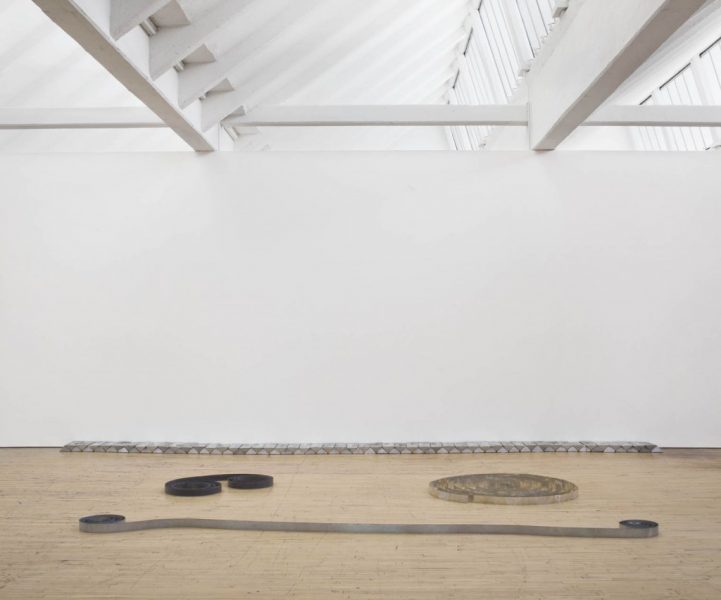
Installation view, Carl Andre: Sculpture as Place, 1958–2010, Dia:Beacon, Riggio Galleries, Beacon, New York. May 5, 2014–March 2, 2015. Art © Carl Andre/Licensed by VAGA, New York, NY. Photo: Bill Jacobson Studio, New York. Courtesy Dia Art Foundation, New York.
Ebony: How did he handle his success? What are his thoughts about the art world today?
Raymond: He really didn’t have much success until after 1973. I don’t know what he thinks of the art world today. It’s hard for me to focus on something like that; it’s ephemeral in any case. Carl has written a lot about the role of artists, but his efforts were never about success in terms of an art-world career. He’s always had a serious engagement with active thinking. The art world was not one of his preoccupations. The concerns were very much Marxist—about materials, labor, political structures, and exchange value. When you have, for instance, a piece of steel manufactured in Pennsylvania or copper plates imported from Chile, there’s a specific economic value. And then this material is turned into art that has surplus value. It becomes a conversation about commodity exchange and value relationships.
Raw material from the earth could be manufactured into bullets or pipes and bridges. What were the political and labor conditions of the place that produced the sheet of steel or copper plate? Andre extracts the material from this exchange. He interrupts it—you could say he sabotages the process of production. What does a sheet of copper mean in political terms? How does the meaning shift when it appears on the floor of a museum or in a Park Avenue apartment? These are the kinds of questions and problems that preoccupied him.
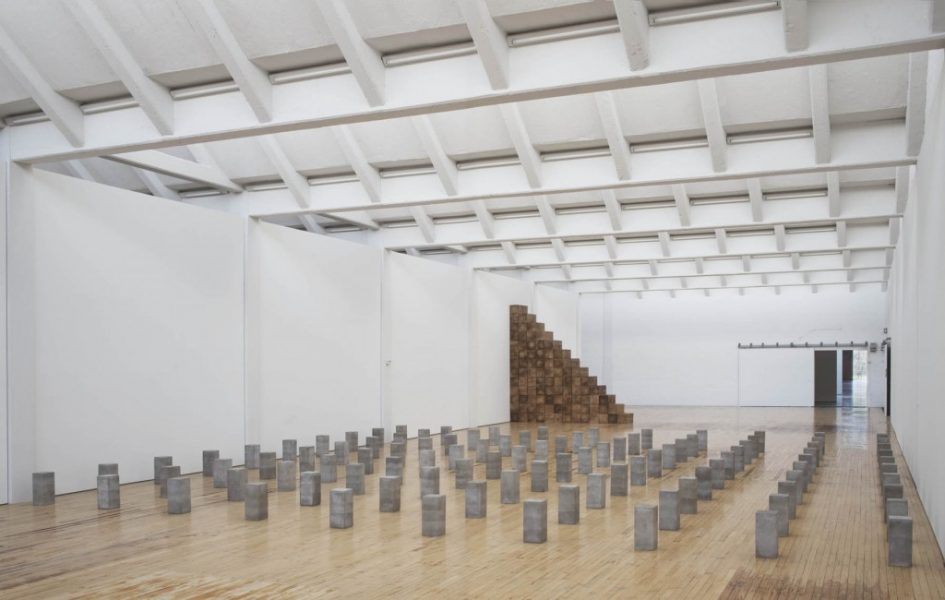
Installation view, Carl Andre: Sculpture as Place, 1958–2010, Dia:Beacon, Riggio Galleries, Beacon, New York. May 5, 2014–March 2, 2015. Art © Carl Andre/Licensed by VAGA, New York, NY. Photo: Bill Jacobson Studio, New York. Courtesy Dia Art Foundation, New York.
Ebony: I know it’s a sensitive topic, but I have to bring up the case of Ana Mendieta. The tragedy significantly affected his life and work.
Raymond: I am surprised that you “have to ask” about that “case”, which I would rather refer to in a more respectful manner—as a personal tragedy. I think it would be irresponsibility, and show a lack of respect, for a museum curator to assess the impact such an event may have had on an artist’s life and work. Saying that a tragic event like that “significantly affected his life and work” sounds rather demagogic to me. I don’t think my opinion on this topic would add anything other than just one more note in a sensationalistic debate on Carl Andre’s life, not his work. The only thing I will emphasize, is the tremendous effort that Carl Andre has made throughout all of his five-decade career—and no matter how harsh or terrible his situation has been in some periods—to remain consistent with the principles of his aesthetic investigation.
Ebony: One of the revelations in the exhibition for me was the poems and other writings on view. To me, they are key to the show and have a close relationship to the sculptures.
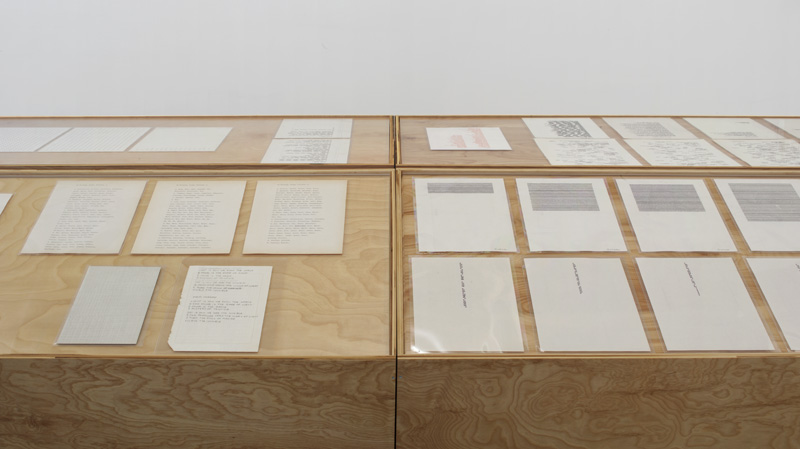
Installation view, Carl Andre: Sculpture as Place, 1958–2010, Dia:Beacon, Riggio Galleries, Beacon, New York. May 5, 2014–March 2, 2015. Art © Carl Andre/Licensed by VAGA, New York, NY. Photo: Bill Jacobson Studio, New York. Courtesy Dia Art Foundation, New York
Raymond: I knew about Carl’s poems early on, but there was a lot more to discover. In the late 1960s, the dealer Seth Siegelaub encouraged Andre to publish his poetry and they produced Seven Books. They were Xerox copies made when the photo-copy machine was a new technology. For each poem he wrote, Carl made several carbon copies. He’d send one to Hollis Frampton or Sol Lewitt, and distributed the others only to his closest friends. The Stedelijk Museum in Amsterdam has a wonderful and in-depth collection of Andre’s poems.
Ebony: The poems make you see the sculptures differently. Maybe it’s because of their physical proximity to the sculptures. When you read a poem in one of the vitrines and then look at the sculptures you start to think about their relationship to language.
Raymond: He’s experimenting here with space on the page, relating to language in the manner of concrete poetry in a way. And some basic shapes of the poems are echoed in the sculptures. But I don’t think they are so closely related. Rather than primarily visual, the writings are definitely language based, but he treats language as matter in space, side by side, unit by unit. The poems are limited to a certain period. There was an intense production in 1958 and ’63, and then from ’67 to ’73, but he basically stopped writing poetry in 1972. Carl never had a studio, so he filled his days composing these word-poems between exhibitions. He created his own universe of language and spent a great deal of time on the poems, which he typed with one finger!
Ebony: Another big surprise in the show is the lower-level gallery with the archival materials and the so-called Dada Forgeries.

Installation view, Carl Andre: Sculpture as Place, 1958–2010, Dia:Beacon, Riggio Galleries, Beacon, New York. May 5, 2014–March 2, 2015. Art © Carl Andre/Licensed by VAGA, New York, NY. Photo: Bill Jacobson Studio, New York. Courtesy Dia Art Foundation, New York
Raymond: Two years ago Manuel Cirauqui [assistant curator at Dia] joined us on this project and conducted the primary research to locate several of these little-known objects. I also have to give credit to Phyllis Tuchman and James Mayer, who mentioned their existence and pointed us in the right direction. The surprise in the show, the Dada Forgeries, are curious objects filled with wit and humor, which many find hard to believe Carl made. With these works, most of which are assemblages built from found objects, he created a dialogue with Duchamp—an argument that is perhaps surprising given his public rejection of Duchamp’s influence early on. But after I got to know Carl, I understood them more. He has a great sense of humor. You actually can find a lot of humor in the well-known sculptures. We started to call this gallery the Julian Pretto room in honor of the late art dealer who was a friend of Carl’s. Pretto showed these works in 1988 and in the early ’90s, before his premature death. Carl also gave some of them as gifts to his friends and peers.
Ebony: What do you hope viewers come away with from the show? What experience are you offering?
Raymond: We all have our own needs for art. As a curator, not just of Carl’s show, but others as well, I feel that there’s the possibility of inspiring an artist. Or converting a non-artist into an artist. I have this idealistic belief that there is the possibility that one day we can all be artists and thrive in a place of inquiry, a place of critique and discovery. If an exhibition like Carl’s can change someone’s notion of what an artwork is, or change someone’s preconception about what defines art, it would be gratifying. Great art should inspire questions and provoke a completely new reading of one’s relationship to reality, to love and to true politics. Whenever I am in front of a great work of art the questions multiply, moving me to think and feel. It is always discomforting but so necessary.
























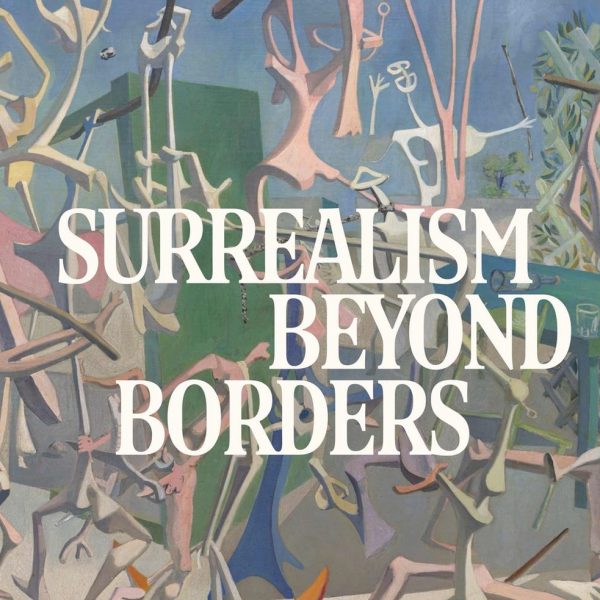
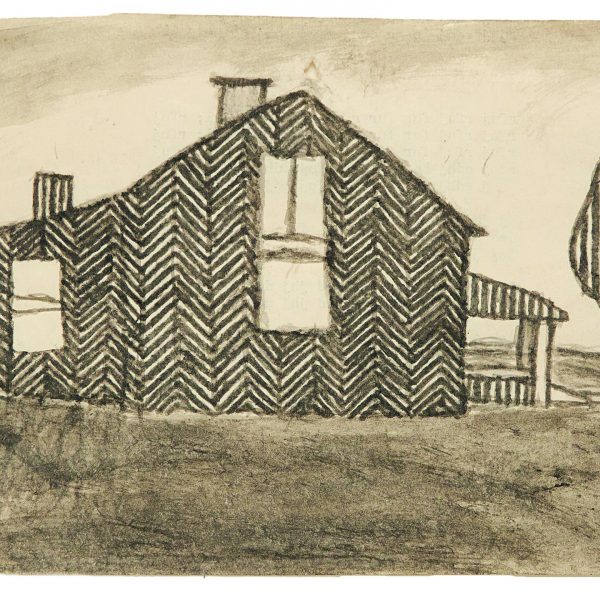
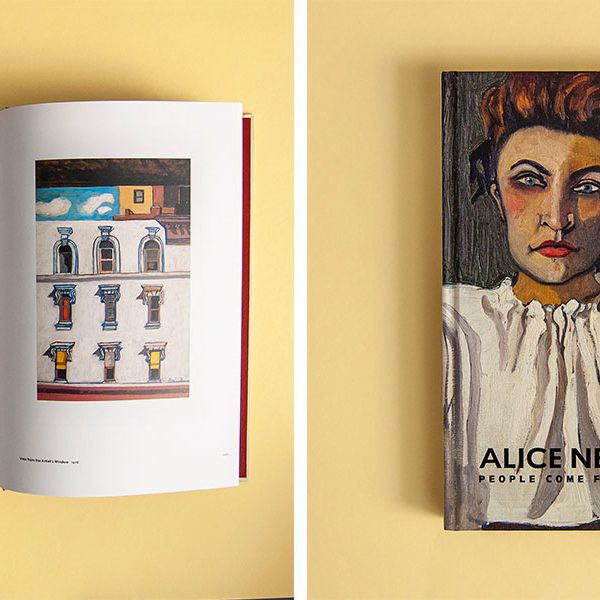
Carl Andre should be serving a life sentence right now. The fact that he can continue as a free man as if nothing has happened is an absolute travesty of justice